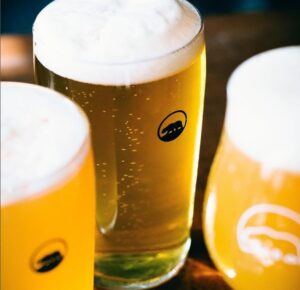This month’s Teachable Moment comes to us from our friends at Alvarado Street Brewery. We’re sharing great insights into HOPS from “Brooksie’s Corner”… Alvarado Street’s Advanced Cicerone, Brooks Crumley, who emailed us this gem below, which I guess would be somewhere on their website too, but it’s just easier to cut and paste 100% of Brooksie’s content here. So grab a cold one, enjoy the read, add Alvarado Street to the top of your brewery visit list, follow them on Instagram, Facebook and subscribe to the ASB newsletter, and enjoy Alvarado Street’s “Mai Tai IPA” on tap at Creekside. And now, Brooks Crumley:
 BROOKSIE’S CORNER:
BROOKSIE’S CORNER:
Hemispheres…. and hops. Northern vs. Southern? What is the big deal? What is the difference? Does it even matter? Is that even a thing?
There are two bands of latitude on earth where hops are able to grow well. Those bands are between 35° and 55° north and 35° and 55° south. As a point of reference 35° north is just about right at the southern border of Monterey County in California. Traveling up the coast from there, you would have to cross over into Canada and get about halfway to Alaska to reach the 55th parallel. It doesn’t seem probable that hops would grow well across such a large area – and that is because they don’t. The duration and quality of sunshine that reaches the earth between the 35th and 55th parallels makes hop growing possible, but there are a lot of other things that need to go right. Hops need fairly moderate and stable temperatures and no frost. Depending on where they grow, they can adapt to different requirements for water. Great soil is also a must. Even if all of those boxes are checked off, you have topography to deal with.
In the United States (which is one of the largest hop producers in the world), the hop growing band covers most of the northern two thirds of the country- but a majority of the hops are grown in the Pacific Northwest. Specifically the Yakima Valley in Washington, the Willamette Valley in Oregon and Treasure Valley in Idaho. There are hops grown in other places in North America like Michigan, New York and parts of Southern Canada (to name a just a few) but their overall production combined is absolutely dwarfed by the Pacific Northwest.
The Northern Hemisphere “band’ also cuts across all of the classic hop growing regions of the world and quite a few you might not be aware of. They include the United Kingdom, Spain, France, Germany, Austria, the Czech Republic, Slovenia, Poland, and Ukraine. Keep going and you run into northwest China and then eventually parts of northern Japan. The world of “Northern Hemisphere” hops is a big world indeed. A Cascade hop from Yakima Valley, a Saaz hop from the Czech Republic and a Sorachi Ace hop from Japan are all going to be completely different in character. So it seems somewhat silly to group them all together with this “Northern Hemisphere” designation. And to be honest, it is not really a thing.
The Southern Hemisphere hop growing band, on the other hand, spans across a lot of, well, ocean. In South America if you draw a line from Santiago Chile across to Buenos Aires in Argentina, everything south of there is in the sweet spot. Limited amounts of hops are grown there with mixed success and usually end up in small regionally produced beers. Head east for a while and the Southern Hemisphere growing band just touches the southern tip of Africa. South African hops are starting to generate a lot of excitement, and while production levels are low, they are on the rise. If we go a little further east you run into southeast Australia and all of New Zealand. Hops from Australia and New Zealand are the new rock stars of the hop world. They are unique and potent, and due to the relative proximity of the growing regions they tend to have attributes that tie them all together. THESE are the hops that most people are referring to when they talk about “Southern Hemisphere” hops. And that very much is a thing.
So what about Northern Hemi, the beer we are releasing for the first time this weekend? What hops are we referring to? Well, the “Northern Hemisphere” hops that we used are those that we are the most familiar with. They are a carefully selected group of hops that grow in the Pacific Northwest, not a collection of hops sourced from the entire northern half of the globe. But the approach is the same as it was with the “Southern” version of our Hemi IPA, we wanted to cram as much of the unique hop character from a single region of the world into a single beer. And we think that we did just that. In other parts of the world hops from the United States are sometimes viewed as too assertive, or too aggressive. Well, we will let you be the judge of that…
Author: Brooks Crumley, Advanced Cicerone®
Alvarado Street Brewery: Instagram, Facebook and subscribe to the ASB
